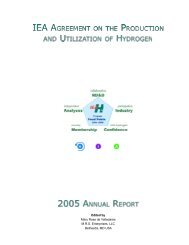Technology Status of Hydrogen Road Vehicles
Technology Status of Hydrogen Road Vehicles
Technology Status of Hydrogen Road Vehicles
You also want an ePaper? Increase the reach of your titles
YUMPU automatically turns print PDFs into web optimized ePapers that Google loves.
! Cryogenic GH 2 is still in the R&D phase, and needs thermal management<br />
! Micro-sphere GH 2 is still in laboratory phase<br />
! LH 2 is good but expensive<br />
! Slush (half solid, half liquid) has 15% higher density than LH 2, but is too difficult<br />
! MH is safe, but needs thermal management, and impurities are problematic<br />
! Organic liquid hydrides (methanol, LNG, MCH) are good if direct use is feasible.<br />
Yamane, K.; S. Furuhama, “A Study on the Effect <strong>of</strong> the Total Weight <strong>of</strong> Fuel and Fuel Tank on the<br />
Driving Performance <strong>of</strong> Cars,” Musashi Institute <strong>of</strong> <strong>Technology</strong>, Tokyo, Japan, pp. 1053-1062.<br />
Using simplified equations, a parameter study was performed to find the influence <strong>of</strong> total weight <strong>of</strong> fuel and<br />
fuel tank on fuel economy, range, starting and running accelerations, maximum grade, and maximum vehichle<br />
speed.<br />
The influence is quite strong, and as far as the various hydrogen options (300 bar GH 2, MH, LH 2) and a battery<br />
EVs are concerned, LH 2 is much superior for driving range and fuel economy. They concluded that to satisfy<br />
the necessary conditions, and therefore an acceptable weight <strong>of</strong> fuel and fuel tank, only LH 2 provides a<br />
practical solution.<br />
Michel, F., et al., “Onboard Equipment for Liquid <strong>Hydrogen</strong> <strong>Vehicles</strong>,” Messer Griesheim, Cologne,<br />
Germany, pp. 1063-1077.<br />
This paper shows how on-board LH 2 storage tanks have improved during the past 20 years: doubling <strong>of</strong> energy<br />
density, and nine times less evaporation rate; in fact, today, no evaporation losses need occur for several days.<br />
The authors also report on the improvements <strong>of</strong> several detailed components that influence the safety and the<br />
fuel supply.<br />
The safety tests were done together with BMW (see Pehr [1996]).<br />
An example <strong>of</strong> new components is a device for pressure control <strong>of</strong> LH 2/GH 2 fed to the engine: a special metal<br />
hydride in the insulation space <strong>of</strong> the cryotank. By varying the heating to the hydride, more or less gas is<br />
formed, changing the heat transfer and therefore the pressure in the inner tank.<br />
Another device maintains a constant low temperature <strong>of</strong> the cold GH 2 to the engine; if this temperature is too<br />
high an ICE suffers power loss; if too low the heat source (engine cooling water) can freeze.<br />
Ogden, J.M., “Development <strong>of</strong> Infrastructure for Refueling <strong>Hydrogen</strong> Engines,” Princeton University,<br />
New Jersey, USA, pp. 1113-1122.<br />
If mandated levels are imposed, the Los Angeles basin will have several 10 5 ZEVs by 2010.<br />
This paper assesses the economics <strong>of</strong> various near-term possibilities for producing and providing GH 2 for<br />
urban transport vehicles, and how a refueling infrastructure might evolve during the next few decades.<br />
Conceptual designs <strong>of</strong> refueling stations and delivery systems were established for each <strong>of</strong> five major options,<br />
in each case supplying 100–1000 cars or 200-300 buses/d for a total per station 0.1-2 million scf/d. The five<br />
options are:<br />
1. NG/LH 2 ; truck LH 2 ; store/vaporize ; fuel vehicle.<br />
2. NG/GH 2 ; pipe GH 2 ; compress/store ;fuel vehicle.<br />
3. Refinery GH 2 ; pipe GH 2 ; compress/store ;fuel vehicle.<br />
58













